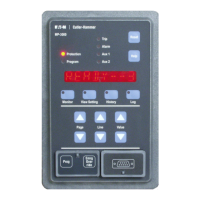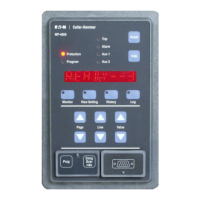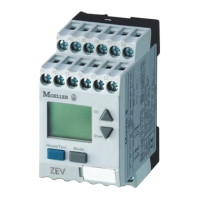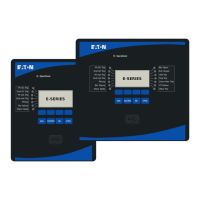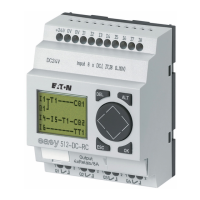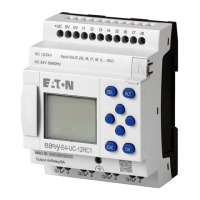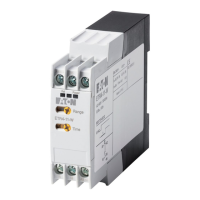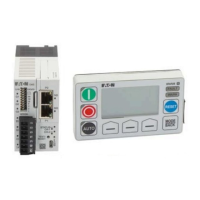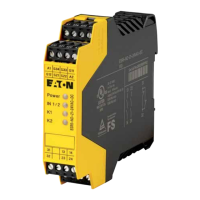Page 5-4
Effective 10/02For more information visit: www.cutler-hammer.eaton.comIL17562BH04
Pay attention to the specific labeled assignments of the eleven URTD
input channels. The first six are specifically intended for up to six
RTDs embedded in the motor stator winding. Inputs 7 and 8 are
specifically for motor bearing RTDs. Inputs 9 and 10 are specifically
for load bearings. Input 11 is an auxiliary general-use input.
All RTD inputs have alarm and trip values set below. But, note that
only the maximum of the values read via stator RTD channels 1
through 6 is used by the MP-3000 motor thermal modeling algorithm.
5.2.1 Setting P2L1, RTD Display Information (RTD IN C or RTD IN F)
Specifies the temperature displays in degrees Celsius or degrees
Fahrenheit.
5.2.2 Setting P2L2, Winding Temp Trip (WD T)
Specifies the motor stator winding temperature limit above which the
hottest winding RTD will cause the relay to trip the motor. This trip can
also be set to OFF. Trip temperature values are in degrees C or F
depending on Setting P2L1 above. There are six specifically-labeled
stator RTD inputs on the URTD module whose readings can trigger
this particular type of trip. See 9.1.8 for setting advice.
CAUTION
IF WD T IS SET TO OFF, THE THERMAL-MODEL PROTECTION
REVERTS TO THE NON-RTD ALGORITHM EVEN IF A URTD IS
CONNECTED.
5.2.3 Setting P2L3, Winding Temp Alarm (WD A)
Specifies the motor stator winding temperature limit above which any
winding RTD will produce an alarm output from the relay. This alarm
can also be set to OFF. Alarm temperature values are in degrees C or
F depending on Setting P2L1 above. There are six specifically-labeled
stator RTD inputs on the URTD module whose readings can trigger
this particular type of alarm.
5.2.4 Setting P2L4, Motor Bearing Trip (MB T)
Specifies the motor bearing temperature limit above which either of
the two motor bearing RTDs will cause the relay to trip the motor. This
trip can also be set to OFF. Trip temperature values are in degrees C
or F depending on Setting P2L1 above. There are two specifically-
labeled motor bearing RTD inputs on the URTD module whose
readings can trigger this particular type of trip.
5.2.5 Setting P2L5, Motor Bearing Alarm (MB A)
Specifies the motor bearing temperature limit above which either of
the two motor bearing RTDs will produce an alarm output from the
relay. This alarm can also be set to OFF. Alarm temperature values are
in degrees C or F depending on Setting P2L1 above. There are two
specifically-labeled motor bearing RTD inputs on the URTD module
whose readings can trigger this particular type of alarm.
5.2.6 Setting P2L6, Load Bearing Trip (LB T)
Specifies the load bearing temperature limit above which either of the
two load bearing RTDs will cause the relay to trip the motor. This trip
can also be set to OFF. Trip temperature values are in degrees C or F
depending on Setting P2L1 above. There are two specifically-labeled
load bearing RTD inputs on the URTD module whose readings can
trigger this particular type of trip.
5.2.7 Setting P2L7, Load Bearing Alarm (LB A)
Specifies the load bearing temperature limit above which either of the
two load bearing RTDs will produce an alarm output from the relay.
This alarm can also be set to OFF. Alarm temperature values are in
degrees C or F depending on Setting P2L1 above. There are two
specifically-labeled load bearing RTD inputs on the URTD module
whose readings can trigger this particular type of alarm.
5.2.8 Setting P2L8, Auxiliary RTD Temp Trip (AX T)
Specifies the auxiliary RTD temperature limit above which the relay will
trip the motor. This trip can also be set to OFF. Trip temperature values
are in degrees C or F depending on Setting P2L1 above. There is one
specifically-labeled auxiliary RTD input on the URTD module whose
readings can trigger this particular type of trip.
5.2.9 Setting P2L9, Auxiliary RTD Temp Alarm (AX A)
Specifies the auxiliary RTD temperature limit above which the relay will
produce an alarm output. This alarm can also be set to OFF. Alarm
temperature values are in degrees C or F depending on Setting P2L1
above. There is one specifically-labeled auxiliary RTD input on the
URTD module whose readings can trigger this particular type of alarm.
5.2.10 Setting P2L10, RTD Diagnostic (DIAG ON or DIAG OFF)
Sets the RTD diagnostic alarm ON or OFF. If set to ON, the relay will
alarm on any RTD failure or URTD communications failure.
5.3 Page 3, SP TRIP, Settings P3L1 to P3L14
This page contains the settings that configure the trip functions. Any
trip function can be turned off as shown in Table 4.3. Start and run
delays are used to block these tripping functions for the set time to
avoid nuisance tripping:
• Start delays—begin when the MP-3000 first sees motor current and
declares a START. The start delay completely inhibits operation of
the governed function for the set time after the start. A single
setting serves for both tripping and alarming functions.
• Run delays—also known as pickup delays. These delays prevent
momentary disturbances in the system from causing nuisance trips.
• When the motor starts, all of the start delays begin timing. As each
start delay expires, the supervised measurement element is
enabled.
• The pickup of a measurement element will begin the timing of its
run delay, which must expire before the relay can actually trip or
alarm. Once the run delay timing has begun, the driving condition
must remain for the full run delay time. If the condition goes away
and then returns during run delay timing, the run delay timer resets
and begins timing over again.
• Note that the transition of the motor or the MP-3000 relay from
START to RUN state has no bearing on any of these time delays.
Timing Example:
Say the MP-3000 jam trip function (see below) is set for a start delay
of 15 seconds and a run delay of 5 seconds. This motor typically
might start and enter the RUN mode in about 5 seconds, but the jam
trip start delay setting inhibits any jam detection for 15 seconds
regardless of this. If a jam occurs (causing the current to rise mark-
edly) 12 seconds after the start, the jam trip function will still be
blocked until the 15 second start delay is expired. Then, the jam
measurement element is enabled. It responds at once, but the 5
second jam run delay must ALSO expire before the relay trips the
motor. In this example, if the jam appears, temporarily clears, and then
returns all during the 15-second start delay, there is no effect on
tripping. But if it temporarily clears and returns while the run delay is
timing, the run delay resets. The jam must return for a sustained 5
seconds before a jam trip occurs.
